Glass is a wonderful and versatile material that is used in numerous applications in our homes and commercial buildings. We utilize sheet glass every day as tabletops, shelves, windows, and shower doors, as well as in its mirrored version as bathroom, bedroom, and decorative mirrors. But most homeowners have no idea how to correctly specify and order glass.
The well-informed consumer can save big bucks on glass and mirrors by understanding the pricing structure of the glass business and by using industry slang when ordering. A typical request should go like this: “1/4 clear annealed glass, 2 lites, 12 * 48, flat polish all”. Learn “Glass-Speak” and save money on your next order of glass or mirror!
Remember that most glass applications are best left to the licensed professional glazier because glass and mirrors can be dangerous and even life-threatening if installed incorrectly.
What Affects the Price of a Sheet of Glass?
Four main factors control the final cost of a sheet or pane of glass (interesting factoid: a sheet of glass is called a “lite” in the glass business):
- Type of glass (for example, clear, bronze, gray, textured)
- Thickness of the glass (typically 1/16″ thru 3/4″ thick)
- State of the glass (annealed or tempered)
- Fabrication costs (typically edgework, notches, or holes)
For an excellent example of how these factors are used to specify a simple glass tabletop – study this web post or watch our video on “How to measure your table for protective glass“.
As an Amazon Associate, I earn from qualifying purchases.
Type of Glass (Tinted or Textured)
Tinted Glass is More Expensive Than Clear
Architectural glass comes in a large variety of tints and each one has a different price – expressed as cost in US dollars per square foot. So-called “clear” glass is the standard for residential applications of all types and is the most affordable.
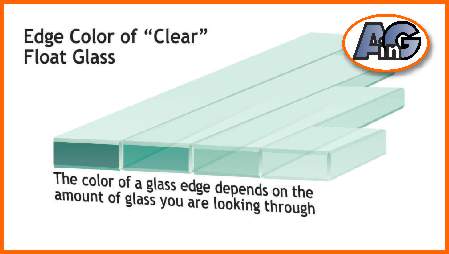
Remember the “clear” glass has a pale green tint owing to the iron content. This tint increases in intensity as you look through increasing thicknesses of glass. So, the edge of a large table will look almost black when viewed from the side.
Specially tinted glasses have higher prices per square foot with the top-of-the-line cost for black glass and crystal-clear or low-iron glass. So tip #1 when calling for prices is to specify the color or tint of glass that you need.
Textured Glass is More Expensive Than Clear
Numerous types of textured architectural glass are available. These are best appreciated by examining them, “in person” in the glass showroom.

Beautiful textured glass varieties are available to provide privacy or to make a fashion statement in your home. Each one costs more than regular “clear” glass but prices vary widely – so ask for estimates for several different types if budget is an issue.
Thickness of Glass
Everything else being equal, the thicker the glass, the higher the price. But it is vitally important not to jeopardize your safety by choosing dangerously thin glass to economize on price. Always consult a glass professional if in doubt.
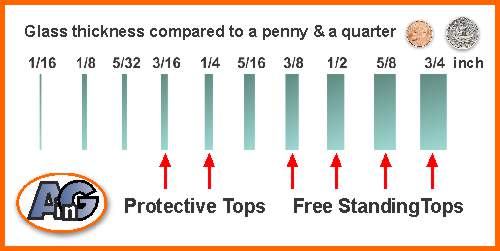
US glass ranges from 1/16″ for picture framing through 1/8″ for windows, 3/16″ and 1/4″ for small shelves and protective tabletops, to 3/8″ & more for heavy glass applications like free-standing tables, shower doors, and room partitions.
The state of the glass – annealed or tempered
Regular glass leaves the factory in a state called annealed. It is then tempered (heat-strengthened) for safety reasons when used for shower enclosures, patio doors, and outdoor furniture. For everything you need to know about tempered glass – study this informative post.
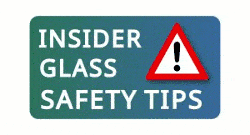
Always consult a professional if in doubt. Glass and mirror are potentially dangerous and even life-threatening if handled and installed incorrectly. Artistry in Glass cannot be responsible for the consequences of actions taken as the result of information on this website.
The decision to use tempered or annealed glass should be made in consultation with your local glass shop. For pricing considerations, note that tempered glass is approximately 10% more expensive than annealed. Also, note the very important fact that tempered glass cannot be cut, polished, drilled, notched, or otherwise modified because once the surface is broken it will shatter into thousand pieces. Polishing and other fabrication procedures are all carried out before the glass is tempered.
Fabrication Costs – Edgework
“Fabrication” is glass speak for the grinding, polishing, beveling, drilling, notching, and other processes used to finish the glass ready for use. The most common fabrication category is called “edgework” – the term used for modifying the sharp, dangerous edge of freshly cut glass and seaming or polishing it to be safe to use.
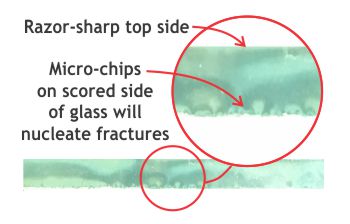
When sheets of glass are cut the freshly cut edges are sharp and dangerous. The simplest way to make the glass safe to use is to sand the sharp edges – this is called seaming in “Glass-speak”. For furniture, more attractive edgework choices are “flat-polished” and “beveled“.
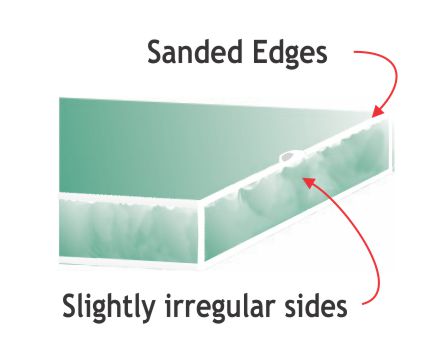
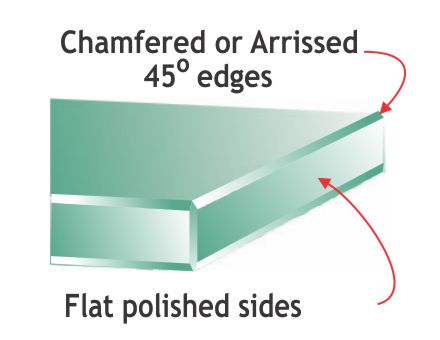
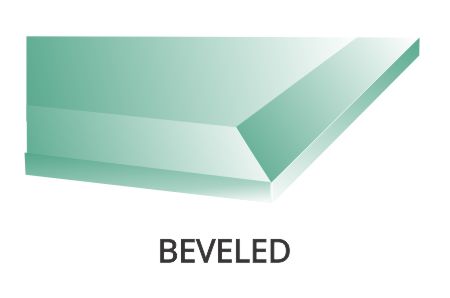
Many uninformed customers mistakenly believe that “beveled” means a smoothed edge whereas it really refers to special, generally, 1″ wide, angled or faceted edge used to decorate the borders of mirrors or high-class furniture. Beveling costs about twice as much as flat-polishing, so be clear about which edgework you really want when ordering from the glass shop.
What are the Costs of the Various Types of Edgework?
Unlike glass, which is priced by the square foot, edgework costs are calculated in dollars & cents per linear inch. Prices vary from shop to shop and from state to state but the table below gives you a rough idea of the costs of various types of edgework on various glass thicknesses.
| Glass Thickness | 1/4″ | 3/8″ | 1/2″ |
| Seamed edge | $0.12/linear inch | $0.16/linear inch | $0.25/linear inch |
| Flat-polished edge | $0.24/linear inch | $0.29/linear inch | $0.39/linear inch |
| 1″ Beveled edge | $0.52/linear inch | $0.95/linear inch | $1.20/linear inch |
| 1 1/2″ Beveled edge | $0.75/linear inch | $1.35/linear inch | $2.20/linear inch |
The costs above are approximate but they illustrate the way that a frugal shopper can save money by ordering a seamed rather than a polished edge if the edge in question will be hidden from view.
How to use Glass-Speak (Technical Glass Language) to Get the Best Pricing From Your Local Glass Shop

The secret to getting the best pricing on glass is to use “Glass Speak“. That is to make the glass shop think you are a professional by using the slang of the glass trade. For best results, speak in a gruff, working-class, contractor-style voice and ask as follows “I’d like your best price on 1/4″ clear annealed glass shelves: I need 4 lites, 8″ by 24” with flat-polished edges.
To reinforce the method: let’s say you are a frugal customer and you know that the back and sides of your glass shelves will not be visible. To save edgework costs you could request that just the front edge of the shelf is polished. So your money-saving “Glass-speak” request would go like this (substitute the number of shelves and the measurements to suit your situation):- “I’d like your best price on 1/4″ thick glass shelves: I need 4 lites of clear annealed glass, 8″ by 24”, each with one long side flat-polished and the other 3 sides seamed”.
Your use of technical jargon will indicate to the glass shop sales associate that you are a knowledgeable customer and that your experience will smooth the sales process – making them more likely to give you beneficial pricing.
Glass-Speak – Technical Jargon for Tempered Glass
To give you another example of glass jargon, this time applied to tempered glass, here is the correct verbiage for ordering a tempered glass patio table with rounded corners (remember to use the gruff voice and practice your smoker’s cough):
“Hi, This is Dale Chihuly calling, I’d like your best price on a patio tabletop. I need 3/16″ clear tempered glass, 1 lite 42″ * 64″, with seamed edges, 1″ radius corners, and a 2″ diameter umbrella hole (please include the etched logo).” This is an example of ordering glass with rounded corners (notice that the corners are specified by the radius of a circle that matches the corners). Re-check this page for more on radius and clipped corners. (The etched logo is a small (<1″) sandblasted identification placed in the corner of a pane of glass to prove to building inspectors that the glass has been tempered – it is often called a “bug” in the glass business).
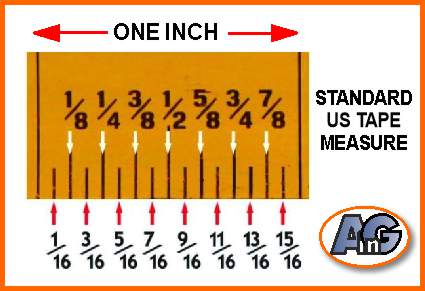
Insider Measuring Tip
Glass sizes in the USA are measured to the nearest 1/16″. Take care when measuring and double-check your dimensions with a second tape. Remember, it is not economical to “grind off” 1/8″ if you order the glass too big. Be sure to read below for an Insider Money-Saving Mega-Tip!
Insider Money-Saving Mega-Tip
In the glass industry, the sizes of glass sheets are rounded up to the next even inch. So, for example, a panel measuring 24 1/16 * 48 1/16 will be priced as if it was 26 * 50. This results in a sq. ft. total of 9.03 compared to the 8 sq. ft. area of a 24 * 48 panel – resulting in a 13% increase in the glass price – just for the indulgence of adding 1/16″. An additional premium will also apply to any edgework – this will be charged for 152 inches rather than 144 inches for the 24 * 48 glass. The moral, for the frugal shopper, is that when the exact measurement is not critical, try to arrange for it to be just under an even inch instead of just over.

Additional Insider Tip
Local glass retailers all get their float glass (standard US glass) from the same wholesalers and there is no difference in the quality. So if you are on a budget, call 2 or 3 local shops to get the best pricing and request an approximate production time. (Always make sure to check their Google testimonials – the cheapest shop may have bad service.)
Consider the Predicament of the Glass Shop Owner
Glass is a cruel mistress and a tricky substance to work with because the transparency makes the slightest scratch or chip very obvious and means that the damaged glass has to be rejected and sent back to the factory. For this reason, the dedicated glazier or glass retailer very much appreciates the patience and understanding of intelligent and compassionate customers.

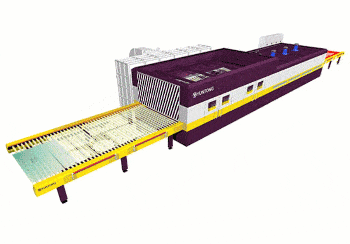
Most glass edgework is done on million-dollar machines in large factories and all the heat-strengthening is done in tempering plants rather than “in-house”. So the final product has to be transported from the factory to the retail glass shop. Whenever glass is handled there is a small chance of damage to the surface or edges.
If your glass shop sends you the wrong size or the wrong color of glass, you have a legitimate complaint, but accidental chips and scratches are out of the control of the humble and honest glass retailer: so on behalf of the union of glassworkers – please exercise patience and understanding when ordering glass – delivery may occasionally take longer than anticipated.
Can I Save Money by Ordering Online?
With the rise of the internet, the power of Amazon has extended its influence even to the glass business. Although we firmly believe in supporting local companies, economics will eventually trump loyalty and certain types of glass are very attractively priced online. Study this post for info on the costs of glass tabletops.
If you are looking for standard-sized, tempered glass tabletops (24″ diameter, clear polished circles, for example), excellent deals are available here on Amazon. I recommend Amazon, especially for free-standing glass tops, for coffee tables, for example, where the exact size is not critical. If you are trying to fit tempered glass into the lip around a metal patio table, it is much safer and wiser to trust a local glass shop.
Example of an imported glass tabletop that will save you big bucks ordered through Amazon.
If your conscience allows you to purchase from China, you will pay about 1/2 the price of a custom US-made top. But remember, the top will be 44″ diameter not a custom size like 43 13/16″ Furthermore delivery will be “curbside” and you’ll need to round up strong teenagers to schlep it into the house.
Can a Glass Company Save Me Money by Cutting My Own Glass?
Customers often wonder if they can save money by having a glass company cut down their own glass. A friendly retailer will occasionally do this either as a favor or in the spirit of recycling (if they are interested in saving the planet). However, most glass companies do not enjoy this job, partly because they make no profit on the glass and a number of things can go wrong. These are some of the issues to be aware of:
- The old glass may break unpredictably – causing customer unhappiness.
- Tempered glass cannot be cut (it will shatter).
- The main cost associated with making a polished glass shelf (for example) is carefully handling, cutting, and polishing the glass, The actual raw material (glass) is a small part of the cost. Most small shops do not have polishing machines (like the one shown above) so the best edgework they can profitably do in-house is seamed.
- Cutting customers’ 1/4″ or 3/8″ glass is probably worthwhile but the cost of edgework on thick glass makes it uneconomic (it does not pay to transport the newly cut glass to and from the fabricating plant).
Artistry in Glass is operating a deliberate eco-friendly policy of cutting our carbon footprint – so we will assist in any way we can to re-purpose your annealed (non-tempered) glass.
Does an old glass tabletop have resale value?
Many customers try to sell or barter their old tabletops when they order a new one. We always help out by disposing of a customer’s unwanted glass BUT the unfortunate truth is that all glass tops that have had even the slightest use have become scratched, dinged, or damaged somehow. Even the slightest defect makes a glass tabletop unsaleable: customers insist on perfectly pristine, unblemished glass. Occasionally, a very minor scratch can be disguised by skillful sandblasting of a design – but these situations are rare.
Glossary of Insider Glass Terms
There are numerous obscure and interesting terms in the decorative glass business. Follow this link to learn all about them.
Check our Numerous Google Testimonials
Follow this link to read our five-star Google testimonials
Call the Glass Experts at Artistry in Glass for Free Advice!
We will give you very competitive pricing in Southern Arizona, so call for free advice on all your glass-related issues. Our shop also specializes in stained glass, etched glass, cabinet glass inserts, protective glass tabletops, glass shelves, and all types of restoration services for antiques.
Glass tabletops & shelves – info from Artistry in Glass
- Benefits of glass shelving – info from experts!
- How much do glass tabletops cost?
- Do glass shelves need to be tempered?
- What is the best thickness for glass shelves?
- Best edge type for glass shelves, polished or beveled?
- How much weight can a wall shelf carry?
- What color glass should my shelves be?
- Glass tabletops – 10 amazing benefits explained
- How to order a glass tabletop
- Best thickness for glass tabletops – expert advice
- Should glass tabletops be tempered?
- Should glass tabletops be beveled?
- How to paint a glass tabletop
- All about tempering glass tabletops!
- How to tell if your glass is tempered
- Can tempered glass be cut?
- How to protect your wood table with glass
- How to fix a scratched glass tabletop
- How to fix a chipped glass tabletop
- How to replace broken patio table glass
- How to measure for a glass tabletop
- Video – how to measure your tabletop
- Plexiglass vs glass – pros and cons
- Beveled glass table base – a case study
- Choosing between tempered & laminated glass
- Glossary of terms used in the glass business
Artistry in Glass was your source for antique repair in Tucson
Check out this amazing selection of informative articles:-
- Where can I get antiques repaired?
- Are broken antiques worth fixing?
- How to fix a broken picture frame
- How to repair a broken china plate
- How to repair a broken china teapot
- How to fix a broken marble slab
- How to repair a broken china coffee mug
- How to repair a 2000-year-old sculpture
- All about repairing stained-glass lampshades
- How to care for your stained glass skylight
- How to repair Dalle de Verre
- Is stained glass worth repairing?
- To repair or toss out?
- Tucson crystal & china repair a division of Artistry in Glass
- What to do with broken antiques
- Is lead crystal dangerous?
- Repairing an antique Mexican statue
- Repairing religious statues
- The history of Swarovski crystal figurines
- How to find the value of a Swarovski Crystal figurine
- Have Swarovski crystal figurines lost value since 2009?
- How to collect Swarovski annual ornaments
- How to display Swarovski crystal figurines
- How to authenticate a Swarovski crystal figurine
- How to display Swarovski annual ornaments
- How to clean Swarovski crystal figurines
- How to repair a Swarovski crystal mouse
- How to repair a Swarovski annual ornament
- How to repair a Swarovski crystal train set
- Fixing broken wine glass stems
- How to clean cloudy glasses
- Why do wine glasses have stems?
- Swarovski Crystal Figurines
- How to repair a chip in a wine glass
- How to fix a scratched glass tabletop
- How to replace a broken patio tabletop
Unique Mirror Resources from Artistry in Glass
Mirror Design & layout
- How are mirrors made?
- What is a beveled mirror?
- What is a two-way mirror?
- Best mirrors for bedrooms
- How to size and position your wall mirror
- How to order custom etched mirrors
- Best places to hang dining room mirrors
- How much do wall mirrors cost?
- Shop the MIRROR Family Package
Mirror Installation & Removal
- How to hang a wall mirror
- How to frame a builder’s grade bathroom mirror
- How to hang a frameless mirror with glue
- Best clips for hanging mirrors
- How to attach a mirror to a closet door
- How to remove a mirror glued to the wall

